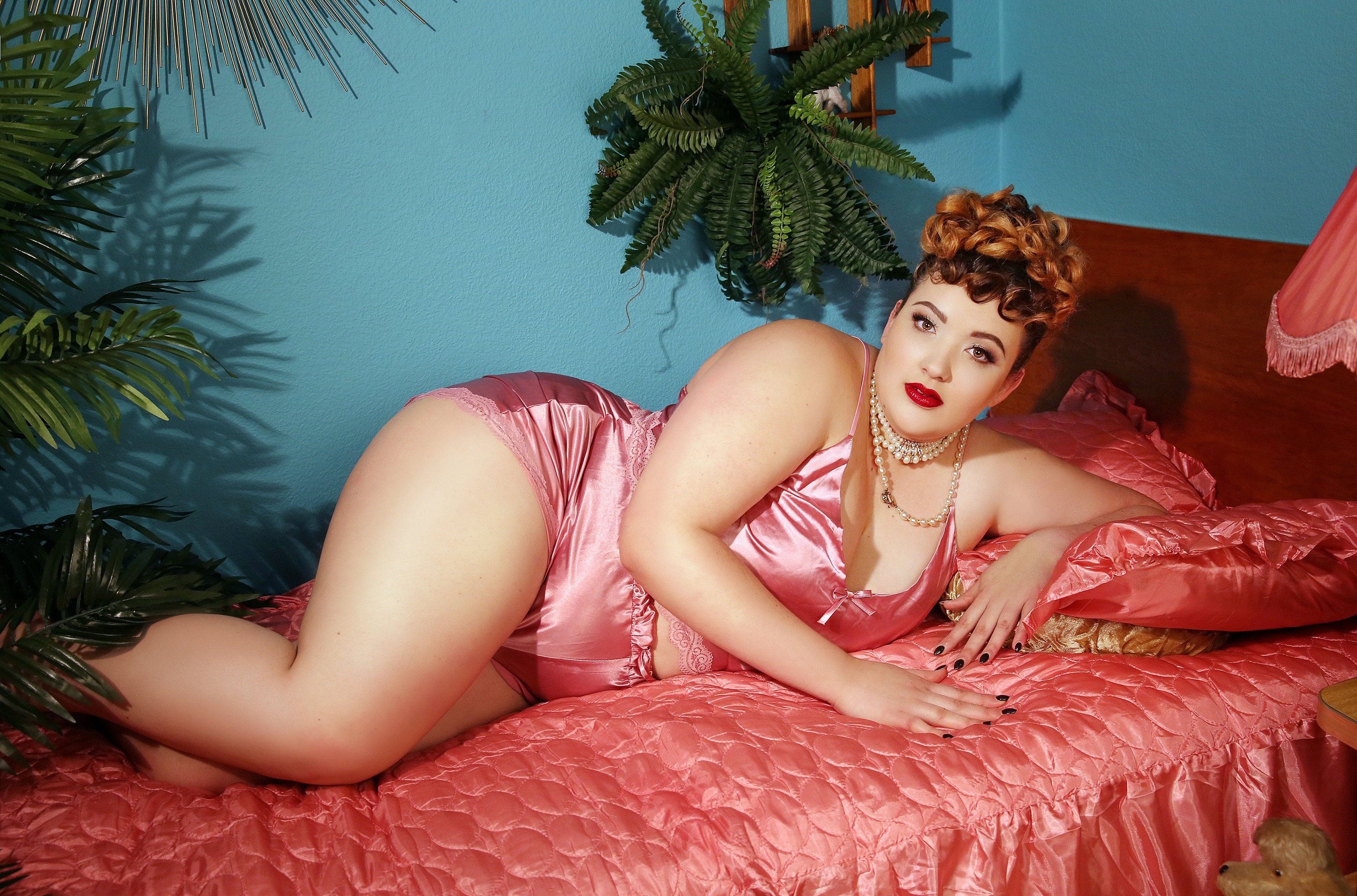Art by Nicola Grimshaw-Mitchell.
I was in the 10th grade the first time I heard the term “fat fetishist.” At 16 years old, and a size 18/20, I was in my first “real” relationship with a male partner. He was a year older than me, with beautiful eyes and a caring nature. He was also respectful, letting me govern the pace of our romantic exploration without any pressure whatsoever. He was, in retrospect, a pretty perfect first boyfriend.
Five or six months into things, however, a friend asked me if I thought he might have a fat fetish. “You know, do you think he’s one of those creeps who gets off on, like, bigger girls?”
I was sheltered, and wholly unfamiliar with the nuanced and diverse fetish communities out there. Still, I had actually heard variations of my friend’s concern since the onset of puberty — when relatives would remark on how I “needed” to lose weight to find a “good” partner; when friends asked things like “do you think [insert potential suitor’s name here] only likes you because you’re fat?”; when I was warned about the kinds of men, always men, who would be drawn to my body. My body, which was unruly and wide and covered in rolls, and could subsequently only ever be appealing to a “monster” or an “abuser.”
I let that friend’s words get to me. After all, she was only echoing everything I had already been taught. My body was a problem — an unsightly thing — so anyone who showed any interest in me must also be a problem. I broke up with my boyfriend, offering him some bullshit reason about his weed smoking and disinterest in academia.
I had already been taught my body was a problem — an unsightly thing — so anyone who showed any interest in me must also be a problem.
For years thereafter, as I got fatter and fatter, I routinely settled for partners (of all genders) who were just sort of kind of okay with the way I looked. I settled for people who obviously felt like they were settling by being with me. I settled for hook-ups who showed blatant disgust upon seeing my back boobs, who avoided touching the softest areas of my body, or physically pulled my shirt down to keep my stomach covered.
Things began changing in my life in 2011, when I met my long-term partner and, simultaneously, discovered work surrounding body positivity. It was fat liberationists, however, who started me on a path of interrogation, ultimately pushing me to figure out whether I really had a problem with my body, or whether it was everyone else’s problem with my body that I’d allowed to govern my narrative.
I started looking at my figure, rather than avoiding my reflection in the mirror. I began experimenting with fashion. I created boundaries among friends and relatives, making my body an “off limits” topic of conversation. I began liking my fat, or perhaps, giving myself permission to like it.
I also felt the joys of intimately being with someone who didn’t enjoy my company “regardless of my body,” but who genuinely appreciated everything I was (every inch of that big body included). During times when we kept our relationship open, I sought to replicate those feelings by dating only those who self-identified as having a “fat fetish,” or being a “fat admirer.” Of course, plenty of people who don’t identity as such can and do like folks of all sizes, but taking this route eradicated the what-if question for me entirely.
I also felt the joys of intimately being with someone who didn’t enjoy my company “regardless of my body,” but who genuinely appreciated everything I was (every inch of that big body included).
Exploring fat fetishism was scary at first. There are very few depictions in popular culture, and those that do exist unfortunately only reiterate the notions that all fat fetishists are A. men and B. abusers. In the film Feed (2005), for example, we are presented with a man who feeds women to death. He feeds them and fucks them and makes predictions for when they will die.
AMC’s Dietland (2018), based on the novel by Sarai Walker, is, overall, a wonderful demonstration of fat liberation, but in episode 8 (“Rad Fatties”) protagonist Plum comes face to face with a violent fat fetishist. After some brief consensual kissing, he aggressively turns her around, grinds onto her bum, and finishes while whispering “I love you, fat ass.”
These moments paint fat fetishists as sexual abusers. I would never claim that there is no manipulation in this world. There is, tragically, abuse in every community, in every sexuality, in the most vanilla, hetero, “normal” of places. There are, undoubtedly, people who seek only to use a fat person for their own sexual gratification, just as there are people who seek only to use thin partners for their own sexual gratification.
However, to disregard anyone who identifies as a “fat fetishist” is to do a major disservice to the people of all genders who find beauty and pleasure within this world. Like Feed and Dietland suggest, there are indeed folks who get off on feeding their partners (they’re called feeders) and sometimes (not always) on seeing a partner gain weight. They aren’t just cis men, they aren’t just straight, they aren’t necessarily thin themselves. They are often in relationships with feedees (again, this can be someone of any gender or identity), who find extreme pleasure in being fed and/or in gaining weight. There are big beautiful women (BBWs) and big handsome men (BHM) who revel in their own softness. There are fat admirers (FAs) who simply gravitate towards bigger people in the way so many folks seem to gravitate towards thin ones.
I no longer feared that my body would confuse or repel prospective partners, I allowed myself to have fun in brand new ways, and I discovered the things I truly want, both in the bedroom and outside of it.
In all categories, there are countless individuals having gloriously affirming experiences. My life changed completely when I joined fat fetish and dating sites online. I no longer feared that my body would confuse or repel prospective partners, I allowed myself to have fun in brand new ways, and I discovered the things I truly want, both in the bedroom and outside of it.
I realized pretty quickly into creating profiles on sites like Fantasy Feeder and Feabie that there would always be invasive people, or people sending D2F texts at 1 a.m. before they’ve even said a simple hello, or those offering unsolicited comments on my appearance (albeit, these comments focused more on my belly than my tits). Much like on Tinder.
But, I also realized pretty quickly that there were endless fat-positive humans interested only in uplifting one another, in making friends, starting long-term relationships, or hooking up with those who share their values and their preferences. Most crucially, there were myriad brilliant, autonomous women reclaiming their fat bodies in the face of so much toxic rhetoric telling them they should hide instead. They were unafraid of jiggling their bellies or grabbing their fat love handles or taking selfies of their double chins or, simply, demanding respect. Their influence irrevocably made me a stronger person.
And, it helped me have much better sex, too.
Marie Southard Ospina is a Colombian-American writer, editor, plus-size fashion blogger, and digital content creator. Her work often explores body image, fat acceptance, parenthood, pop culture, and sexuality. She is partial to dark comedies, cream cheese, and glitter.

